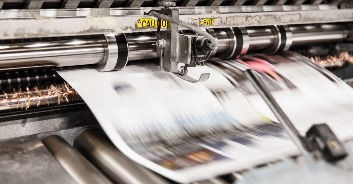How to choose the perfect paper weight for your next print project?
- Marcus Bowen
- Dec 19, 2024
- 4 min read
With so many different types of paper to choose from when you start your print project it can be difficult to decide which one will work best. Will a lightweight paper be too flimsy and leave your project less than durable? If you try to go too heavy weight will it blow your budget? And when you need to give a number what does 120 GSM feel like and more importantly what does GSM even mean?!
If you struggle to know what to choose and can’t distinguish your page paper from your brochure covers this handy guide breaks down everything you need to know with some handy hints and tips on what paper weights are suitable for what kind of projects.
How do printers measure paper weight?
In general, paper weight is measured in GSM (grams per square meter). Put simply, if you were to take a 1m² piece of a certain type of paper, how much would it weigh in grams?
Generally, the higher the GSM number, the thicker and higher quality the paper is.
Why does paper choice matter?

The type of paper you choose can either make or break a printing project. It helps to define durability and the quality of the product.
Go too thin and even the most beautiful designs can feel cheap and flimsy. They will fail to make a good impression and could struggle to last the distance. The print might even bleed through the pages.
However, thicker doesn’t always mean better. For large brochures pages that are too thick could be difficult to bind and for a simple flyer high end thickness might not be cost effective.
Getting the right type of paper for each project is crucial and helps to define whether your business cards will appear professional, if your brochure will last or your poster will stand out.
How do I know which paper weight is right for my project?
Which paper weight you chose will depend on many factors such as the durability you need, the feel you require and your budget. However, to give you an idea of what types of paper suit what projects we have broken down your options to show you what they can be used for.
90 – 120 gsm
The weight of your average copier and printer paper tends to be around 80-100gsm. This is the paper you might use every day for printing off standard documents and invoices.
If you’re looking for something a little fancier like a letterhead or a compliment slip, you’d want to go for 100-120gsm. This paper weight is commonly known as offset paper. It takes colour well and can be printed and written on repeatedly.
130-170gsm
For posters 130-170gsm is a great paper weight due to its hardwearing qualities.
To show off any high-quality images, opt for thicker 130-170gsm art paper. This offers extra durability – perfect for visual marketing products.
200-300gsm
This offers a nice, durable paper with a heavier look and feel. Think paperback book covers or premium flyers. Bear in mind, if you run a lot of direct mail campaigns – this might push the delivery cost up slightly.
300-400gsm
Classed as card, any paper weight between 300-400gsm will provide a superb finish for high quality printed business cards, postcards, leaflets, presentation folders and wedding stationery. Paper within this range is impressively thick, will stand up under its own weight and will certainly deliver an impact. If it’s a superior finish that you’re looking for, then 300-400gsm paper weight will always prove a good choice.
Things to consider before making a decision
If you are unsure what look you want to create then your printers will usually be on hand to help. At LG Davis we have over 60 years of experience in the industry so our sales team are more than happy to give you some advice on what will work best.
Things to consider are:

Use
You need to be clear on what the printed materials are being used for. Are they going to be used outdoors and require encapsulation? Do you need to bind the end materials together or will they be stand alone products? Knowing any other finishes that are required will help your printers to know what papers are suitable.
Durability
Is it a one off project or is this a showcase brochure that will need to stand the test of time? Different papers have different durability levels so knowing how long your project will need to last will help determine how thick the paper will need to be.
Budget
Although it shouldn’t be the only driving force getting the best look for your budget is very important. If you want to give a high end, professional feel to print it is important you chose a finish which elevates the look. Also consider whether it will be more cost effective to print in bulk. At LG Davis you can get all the benefits of bulk buy prices while getting convenient smaller deliveries as and when you need them. Look at quantity as well as finish to find the right price for your project.
Quick reference guide
Still unsure which paper to choose here is a quick guide to average upper and lower limits for different types of projects so you can gauge what you might need.
Copier paper 80 – 100gsm
Letterhead 90 – 120gsm
Brochures 130 – 250gsm
Posters 130 – 170gsm
Flyers and leaflets 130 – 170gsm
Greeting cards 350 – 400gsm
Business cards 350 – 400gsm
Looking for some extra help? Our talented sales team are more than happy to show you samples and talk through the different paper options before you place your order.
Take the hassle out of print choices and talk to us if you need any extra help confirming the paper weights for your next project.












































Comments